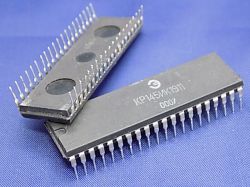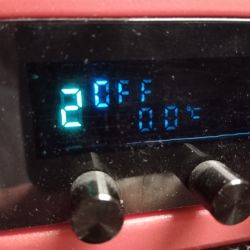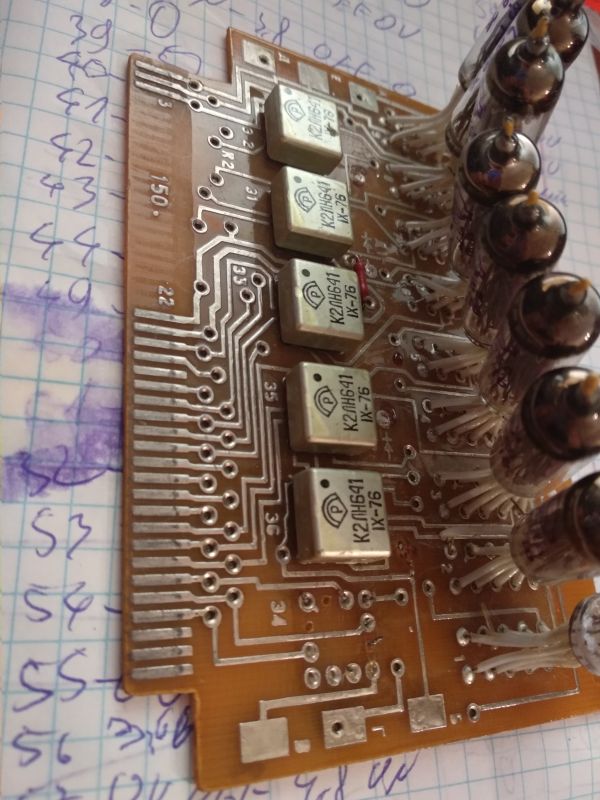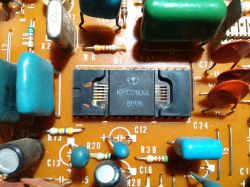The increasing popularity of VFD displays, their relatively low price and interesting appearance prompted me to build a clock based on such a display.
The heart of the clock is one of the oldest specialized Soviet microcircuits for electronic clocks, made in the p-MOS technology КР145ИК1911 (KR145IK1911) in a 40-DIP housing. The system can control external devices or simply serve as an alarm clock and timer. I did not use these functions in my solution. The whole thing was assembled on a universal printed circuit board.
The power section remained on the original board from the damaged clock. The КР145ИК1911 microcircuit requires a -27V DC power supply, which comes from a stabilizer based on a rectifier bridge, zener diodes and a transistor. A low-power transformer with two secondary windings is used, one to obtain a voltage of -27V and the other to obtain an alternating filament voltage of 5V. Since the display heating circuit is also the cathode, the transformer has a tap in the middle of the winding. In order to extend the life of the display, the glow voltage is reduced to approximately 4.8V. The clock is also equipped with a main oscillator maintenance system based on two A23 batteries connected in series.
A seven-segment digital code is generated at the outputs of the microcircuit 12-18. The VFD display ИВЛ1-7/5 (IVL1-7/5) with multiplex control is used to indicate the numbers. Signals from the КР145ИК1911 system control the potential of the anodes of individual digits and service characters, ensuring their alternate activation. Only one digit is displayed at a time, but the transition from one digit to another occurs at a frequency of 500 Hz, which makes the digits on the display appear to be continuous to our eyes. The display`s service characters (dots) are flashed by giving a 1Hz signal from output 22. The clock also has a blanking function that does not indicate zero when displaying single-digit hours, based on the BC313 transistor and two resistors.
The main oscillator is located inside the microcircuit and connected to a standard watch quartz crystal resonator with a frequency of 32.768kHz. The oscillator was initially connected to a resonator system and two 20pF capacitors. However, its accuracy was not satisfactory, as I wrote about here: https://www.elektroda.pl/rtvforum/topic3852502.html.
Therefore, I decided to add additional capacity to the system in the form of a 4.2-20pF trimmer capacitor. Despite numerous attempts to adjust the frequency and replace the capacitors with slightly larger capacity (22pF), I decided to look for a different solution.
Original version of the clock:
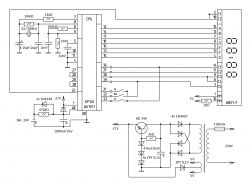
Finally, I used a specialized DS32kHz circuit from Dallas as an oscillator, which is a temperature-compensated crystal oscillator (TCXO) with an output frequency of 32.768kHz. It is powered by the UL75P05 stabilizer with a voltage of 5V, the system also has a power supply backup based on the reserve power supply of the main oscillator of the КР145ИК1911 system. The DS32kHz system used, according to the manufacturer, has a deviation of ±2ppm, which results in ±1 minute / year (0.17 seconds / day). The system works perfectly, the clock is very accurate. Currently, after three months of continuous operation of the clock, the deviation from real time was approximately +0.03 seconds/day (+0.9 seconds/month), which gives an accuracy of ±0.3 ppm! After a year of trouble-free operation, the deviation was 6 seconds.
According to the manufacturer`s data sheet, to obtain greater running stability, it is worth powering the DS32kHz system with a voltage close to 5V (preferably about 4.9V), as you can see, it gives very good results.
The UL75P05 voltage stabilizer and the BC313 transistor used come from the era and are manufactured by the Polish CEMI, made in TO39 metal "hat" housings.
Final wiring diagram:
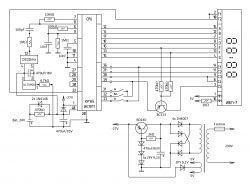
Plate:
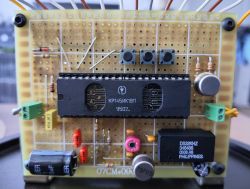
Clock appearance:
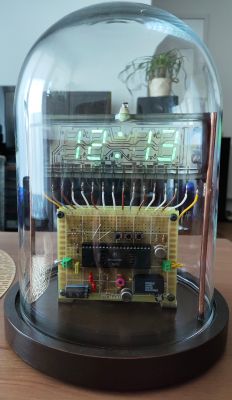
The heart of the clock is one of the oldest specialized Soviet microcircuits for electronic clocks, made in the p-MOS technology КР145ИК1911 (KR145IK1911) in a 40-DIP housing. The system can control external devices or simply serve as an alarm clock and timer. I did not use these functions in my solution. The whole thing was assembled on a universal printed circuit board.
The power section remained on the original board from the damaged clock. The КР145ИК1911 microcircuit requires a -27V DC power supply, which comes from a stabilizer based on a rectifier bridge, zener diodes and a transistor. A low-power transformer with two secondary windings is used, one to obtain a voltage of -27V and the other to obtain an alternating filament voltage of 5V. Since the display heating circuit is also the cathode, the transformer has a tap in the middle of the winding. In order to extend the life of the display, the glow voltage is reduced to approximately 4.8V. The clock is also equipped with a main oscillator maintenance system based on two A23 batteries connected in series.
A seven-segment digital code is generated at the outputs of the microcircuit 12-18. The VFD display ИВЛ1-7/5 (IVL1-7/5) with multiplex control is used to indicate the numbers. Signals from the КР145ИК1911 system control the potential of the anodes of individual digits and service characters, ensuring their alternate activation. Only one digit is displayed at a time, but the transition from one digit to another occurs at a frequency of 500 Hz, which makes the digits on the display appear to be continuous to our eyes. The display`s service characters (dots) are flashed by giving a 1Hz signal from output 22. The clock also has a blanking function that does not indicate zero when displaying single-digit hours, based on the BC313 transistor and two resistors.
The main oscillator is located inside the microcircuit and connected to a standard watch quartz crystal resonator with a frequency of 32.768kHz. The oscillator was initially connected to a resonator system and two 20pF capacitors. However, its accuracy was not satisfactory, as I wrote about here: https://www.elektroda.pl/rtvforum/topic3852502.html.
Therefore, I decided to add additional capacity to the system in the form of a 4.2-20pF trimmer capacitor. Despite numerous attempts to adjust the frequency and replace the capacitors with slightly larger capacity (22pF), I decided to look for a different solution.
Original version of the clock:

Finally, I used a specialized DS32kHz circuit from Dallas as an oscillator, which is a temperature-compensated crystal oscillator (TCXO) with an output frequency of 32.768kHz. It is powered by the UL75P05 stabilizer with a voltage of 5V, the system also has a power supply backup based on the reserve power supply of the main oscillator of the КР145ИК1911 system. The DS32kHz system used, according to the manufacturer, has a deviation of ±2ppm, which results in ±1 minute / year (0.17 seconds / day). The system works perfectly, the clock is very accurate. Currently, after three months of continuous operation of the clock, the deviation from real time was approximately +0.03 seconds/day (+0.9 seconds/month), which gives an accuracy of ±0.3 ppm! After a year of trouble-free operation, the deviation was 6 seconds.
According to the manufacturer`s data sheet, to obtain greater running stability, it is worth powering the DS32kHz system with a voltage close to 5V (preferably about 4.9V), as you can see, it gives very good results.
The UL75P05 voltage stabilizer and the BC313 transistor used come from the era and are manufactured by the Polish CEMI, made in TO39 metal "hat" housings.
Final wiring diagram:

Plate:

Clock appearance:

Cool? Ranking DIY





